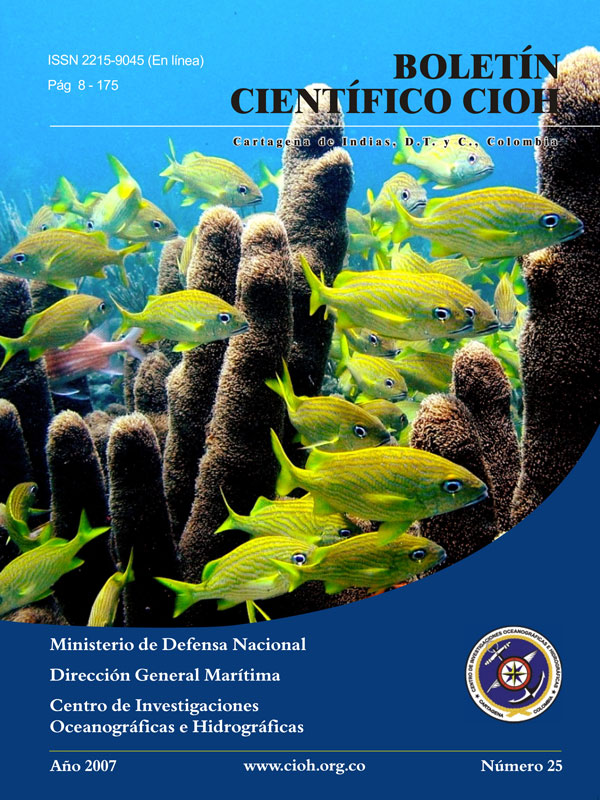Hurricanes and Tropical Storms in the Colombian Caribbean Sea since 1900
DOI:
https://doi.org/10.26640/22159045.162Keywords:
Hurricanes, cyclonic season, Caribbean SeaAbstract
With the exception of the San Andres and Providence Islands, the Colombian Caribbean has been characterized as a zone of low probability of tropical storms formation and development, according to the National Oceanic and Atmospheric Administration (NOAA). This does not mean that such events have not happened in the Colombian Caribbean coast; Irene in 1971, Joan in 1988, and Bret in 1993, are some examples of storms which passed through the Colombian coasts in the past. The increase in the number and intensity of storms which have crossed the Caribbean Sea during the last decade make evident the necessity of beginning an assessment of the effects of these phenomena in the shore zone for strengthening the warning programs where cyclonic swelling and heavy seas represent the most important oceanic effects of the passage of an event of such a nature. This paper presents are vision and analysis of the storms which have passed through the Colombian Caribbean since 1900, their characteristics and the shore threat they represent. It has been established that the last 17 years have been very active and it is also observed how the high 2005 cyclonic activity coincides with the substantial global temperature increase. Some global warming experts agree that the intensity or the number of storms in the Atlantic could increase because of the ocean superficial temperature increase.Downloads
References
[2] Mo K, GD Bell and WM Thiaw (2001), Impact of sea surface temperature anomalies on the Atlantic tropical storm activity and West African rainfall, J. Atmos. Sci., 58, 34773496.
[3] Rubiera J. Early Warning for Hurricanes. Thematic Session Cluster 2 World Conference on Disaster Reduction. Kobe, Japan. January 1822, 2005.
[4] Zandbergen P. Exposure of US counties to Atlantic tropical storms and hurricanes, 18512003. Nat Hazards. Springer. May 2008.
[5] Bell Kand Ray P. North Atlantic Hurricanes 1977-99: Surface Hurricane-Force Wind Radii Atlantic Sea Surface Temperatures and Tropical Cyclone Formation. Monthly Weather Review. Vol. 132.2004; 1167-1189.
[6] Shapiro Lloyd Jand Goldenberg Stanley B. Atlantic Sea Surface Temperatures and Tropical Cyclone Formation. Journal of Climate. Vol. 11. 1997; 578-590.
[7] Unisys Weather Tropical Data Department [PáginaWeb] [Actualizada 2007 Febrero 1; Citada 2006 Febrero 15], Disponible en: http://weather.unisys.com/hurricane/atlantic/index.html.
[8] IPCC, 2007: Cambio climático 2007: Informe de síntesis. Contribución de los Grupos de trabajo I, II y III al Cuarto Informe de evaluación del Grupo Intergubemamental de Expertos sobre el Cambio Climático [Core Writing Team, Pachauri RK, Reisinger A y Equipo principal de redacción (directores de la publicación)]. IPCC, Ginebra, Suiza.
[9] Ortiz J. C, López F., Estrada E., y Bacca L. F., Estudio y simulación del huracán Joan sobre la costa Caribe colombiana incluyendo la isla de San Andrés en 1988. Revista de la Sociedad Colombiana de Física. Vol. 40 No. 2, 2008.
Downloads
Published
Issue
Section
License
Attribution — You must give appropriate credit, provide a link to the license, and indicate if changes were made. You may do so in any reasonable manner, but not in any way that suggests the licensor endorses you or your use.
NonCommercial — You may not use the material for commercial purposes.
NoDerivatives — If you remix, transform, or build upon the material, you may not distribute the modified material.
No additional restrictions — You may not apply legal terms or technological measures that legally restrict others from doing anything the license permits.



